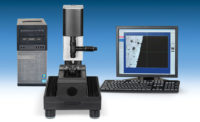LONDON, UK- The mature world coordinated measuring machines (CMM) market is slated to grow at a compound annual growth rate (CAGR) of 4.6% from 2010 to 2015, driven by pent-up demand and product introductions during the short and medium terms, says market research and consultation company Frost & Sullivan.
New analysis from Frost & Sullivan in the world coordinated measuring machines market, finds that the market earned revenues of $1.43 billion in 2010 and estimates this to reach $1.79 billion in 2015.
New opportunities have unfolded as built-up demand post-recession is unleashed to energize market prospects. There is a distinct shift in the usage of CMM from quality control to process control. The use of dimensional measurement by vendors to check the process involved has contributed to the growing utilization of CMMs in process control.
Manufacturers in this domain are rolling out application-specific products that provide better ROI. These machines are custom built to cater to varying end-user requirements. The upsurge in made-to-order manufacturing has augmented revenues of application-specific machines. Vendors are increasing their focus on temperature compensation, high-speed data-gathering sensor technology, and software improvements.
“For vendors in this space, the accent is on non-contact probing technology,” says Frost & Sullivan Industry Analyst Prathima Bommakanti. “Laser-based non-contact probes, which have great advantages in the amount of data acquired and the speed with which it is obtained, are highly accepted in the automotive and aerospace industry.”
In the aftermath of the recent economic crisis, the CMM market has become highly price-sensitive. Vendors are under pressure to produce dramatic results, often while operating on shoe string budgets. The low-end and mid-range CMM segments, in particular, are witnessing high price pressure. Major CMM end users such as aerospace, automotive, and machine shops have gradually shifted from standardized production processes to custom jobs.
The automotive industry too has moved away from producing large quantities of identical engine blocks to a few thousand similar pieces, as the engine designs change every year and the vehicle models in the market have proliferated. Market participants find it challenging to keep in step with changing customer needs.
Slow replacement rates have also curbed market progression. Being robust, CMM equipment does not wear out as fast as other industrial products. Although some parts need to be replaced over time, there is often no need to buy a new machine for years. The average replacement rates for CMM can be higher than 10 to 15 years, thus affecting the sale of the new machines.
“To survive in this landscape, smaller regional suppliers must enhance awareness levels on their technologies and focus on offering better value propositions,” concludes Bommakanti. “Besides, they must expand their operations in emerging economies such as China and India, either by setting up new facilities or through individual agents.”
If you are interested in more information on this study, please send an email to Anna Zanchi, Corporate Communications, at [email protected] with your contact details.
Get our new eMagazine delivered to your inbox every month.
Stay in the know with Quality’s comprehensive coverage of the manufacturing and metrology industries.
SIGN UP TODAY!Copyright ©2024. All Rights Reserved BNP Media.
Design, CMS, Hosting & Web Development :: ePublishing


